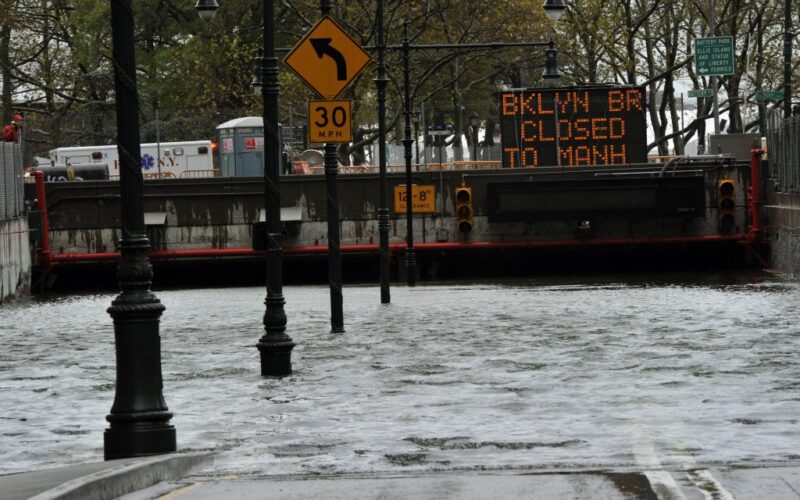Tomorrow, Oct. 29, marks 13 years since Superstorm Sandy flooded Lower Manhattan. The storm cost the city more than $70 billion in damage — equivalent to $95 billion today — and sent a clear warning that our infrastructure was not sufficient to meet the increasing threat of climate change. While we’ve made great strides restoring and protecting our coastline since 2012, the need to continue adapting persists.
This vulnerability reflects a broader, national crisis. In 2024, the U.S. experienced 27 catastrophic climate disasters, resulting in hundreds of lives lost and billions in damage. These events are now routine. Every summer, relatively mild storms flood our subways and streets. Along Manhattan’s West Side, high tides alone can flood parts of the neighborhood during a full moon.
That’s why the Battery Park City Authority (BPCA) is leading two resiliency projects as part of the Lower Manhattan Coastal Resiliency initiative. These are not theoretical solutions — they are being built right now, informed by years of conversation and already delivering results.
Too often, government gets stuck in red tape and ideas die in bureaucracy. In Battery Park City, we are proving that we can execute bold ideas before delay courts disaster.
Wagner Park, one of the neighborhood’s most beloved green spaces, reopened this summer and is once again humming with New Yorkers enjoying its lawns, pathways and views. Elevated out of the 100-year flood plain, it now conceals a floodwall, a modern stormwater system and a 63,000-gallon tank to reuse rainwater.
The benefits extend beyond Battery Park City — they help protect lower Manhattan against a 100-year storm based on projected sea level rise. The project was built to Waterfront Alliance’s rigorous Waterfront Edge Design Guidelines standards that push projects to go above and beyond standard resilience and environmental requirements.
Later this year, the North/West Battery Park City Resiliency Project will break ground, creating a critically-needed coastal flood risk management system. This engineering marvel will create a reliable, passive control barrier that requires no human intervention in the event of a severe storm. It will also preserve the waterfront, maintain open space and introduce universal access, all while minimizing disruption to existing infrastructure.
This is not the first time aspiration and collaboration have come together to deliver public benefit. In the aftermath of the Sept. 11 attacks, plans to rebuild the Port Authority-owned land at the site were floundering, with competing visions, delays and budget issues. Eventually, strong leadership delivered a new World Trade Center and 9/11 memorial in time for the 10th anniversary. It remains one of the city’s shining examples of resilience and architectural ambition.
It is no easy feat to overhaul core public assets in a densely populated area but when a plan is methodically crafted, grounded in science, and shaped by community input, it’s poised to succeed.
For years, the BPCA has laid the groundwork with residents and businesses to gather feedback and make sure final designs reflect local priorities. Coastal communities planning their own large-scale resiliency projects should look to Battery Park City as a model.
While complex in design, the south and north/west sections will provide numerous benefits to Battery Park City and lower Manhattan. Together, they will protect the homes of tens of thousands of New Yorkers, office buildings that drive the city’s economy and essential pieces of infrastructure like the World Trade Center.
The improved shoreline will safeguard against flooding, projected sea level rise and help cool the neighborhood from extreme heat. The removal of Battery Park City from the flood zone will provide relief to homeowners, eliminating the need to purchase flood insurance for federally backed mortgages, and the reconstruction of approximately 1,200 feet of bulkhead will enhance environments that support marine life, a vital part of our ecosystem. Plus, the project is fiscally sound, generating more than $2 in benefit for each dollar invested.
The work happening in Battery Park City joins resiliency work on Manhattan’s East Side to strengthen low-lying perimeter areas from flood risk and sea level rise. It is a monumental undertaking, but the new Wagner Park and the completed phases of the East Side Coastal Resiliency Project show it can be done while transforming our public spaces.
As we reflect on Superstorm Sandy and its wake-up call for the city, lessons were learned and now we must stay focused on following through. As neighborhoods around the city — and cities around the country — look for inspiration amid bureaucratic morass and federal inaction, Battery Park City provides the blueprint for getting it done.
Mann is president and CEO of the Battery Park City Authority. Ward is the interim president and CEO of the Waterfront Alliance.








